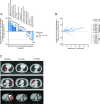First-in-human dose escalation trial to evaluate the clinical safety and efficacy of an anti-MAGEA1 autologous TCR-transgenic T cell therapy in relapsed and refractory solid tumors
- PMID: 39038917
- PMCID: PMC11268062
- DOI: 10.1136/jitc-2023-008668
First-in-human dose escalation trial to evaluate the clinical safety and efficacy of an anti-MAGEA1 autologous TCR-transgenic T cell therapy in relapsed and refractory solid tumors
Abstract
Rationale of the trial: Although the use of engineered T cells in cancer immunotherapy has greatly advanced the treatment of hematological malignancies, reaching meaningful clinical responses in the treatment of solid tumors is still challenging. We investigated the safety and tolerability of IMA202 in a first-in-human, dose escalation basket trial in human leucocyte antigen A*02:01 positive patients with melanoma-associated antigen A1 (MAGEA1)-positive advanced solid tumors.
Trial design: The 2+2 trial design was an algorithmic design based on a maximally acceptable dose-limiting toxicity (DLT) rate of 25% and the sample size was driven by the algorithmic design with a maximum of 16 patients. IMA202 consists of autologous genetically modified cytotoxic CD8+ T cells expressing a T cell receptor (TCR), which is specific for a nine amino acid peptide derived from MAGEA1. Eligible patients underwent leukapheresis, T cells were isolated, transduced with lentiviral vector carrying MAGEA1-specific TCR and following lymphodepletion (fludarabine/cyclophosphamide), infused with a median of 1.4×109 specific T cells (range, 0.086×109-2.57×109) followed by interleukin 2. SAFETY OF IMA202: No DLT was observed. The most common grade 3-4 adverse events were cytopenias, that is, neutropenia (81.3%), lymphopenia (75.0%), anemia (50.0%), thrombocytopenia (50.0%) and leukopenia (25.0%). 13 patients experienced cytokine release syndrome, including one grade 3 event. Immune effector cell-associated neurotoxicity syndrome was observed in two patients and was grade 1 in both. EFFICACY OF IMA202: Of the 16 patients dosed, 11 (68.8%) patients had stable disease (SD) as their best overall response (Response Evaluation Criteria in Solid Tumors V.1.1). Five patients had initial tumor shrinkage in target lesions and one patient with SD experienced continued shrinkage in target lesions for 3 months in total but had to be classified as progressive disease due to progressive non-target lesions. IMA202 T cells were persistent in peripheral blood for several weeks to months and were also detectable in tumor tissue. Peak persistence was higher in patients who received higher doses.
Conclusion: In conclusion, IMA202 had a manageable safety profile, and it was associated with biological and potential clinical activity of MAGEA1-targeting genetically engineered TCR-T cells in a poor prognosis, multi-indication solid tumor cohort.
Trial registration numbers: NCT04639245, NCT05430555.
Keywords: Adoptive cell therapy - ACT; Solid tumor; T cell Receptor - TCR.
© Author(s) (or their employer(s)) 2024. Re-use permitted under CC BY-NC. No commercial re-use. See rights and permissions. Published by BMJ.
Conflict of interest statement
Competing interests: MBH, AM, AS, MK, KP, ASM, DK, and SW were employees of Immatics US in the course of this work and may have securities from Immatics. SG-G, KA, SS, JH, MAK, AA, LB, MB, SB, CW, OS, AM-M, NH, and CMB were employees of Immatics Biotechnologies in the course of this work and may have securities from Immatics. AMT: Clinical trial research funding (received through the institution): OBI Pharma USA, Immatics, Parker Institute for Cancer Immunotherapy, Agenus, Tempus, Tvardi, Boston Biomedical, Karus Therapeutics; Consulting or advisory role: Vincerx, Diaccurate, BrYet, Nex-I, Macrogenics, BioEclipse. BSA: Two patents sold to GreenJay Therapeutics, privately held. IIW’s ASCO COI form is up to date. JJL: Data and safety monitoring board: Abbvie, Agenus, Amgen, Immutep, Evaxion; Scientific advisory board: (no stock) 7 Hills, Affivant, BioCytics, Bright Peak, Exo, Fstar, Inzen, RefleXion, Xilio (stock) Actym, Alphamab Oncology, Arch Oncology, Duke Street Bio, Kanaph, Mavu, NeoTx, Onc. AI, OncoNano, physIQ, Pyxis, Saros, STipe, Tempest; Consultancy with compensation: Abbvie, Agenus, Alnylam, Atomwise, Bayer, Bristol-Myers Squibb, Castle, Checkmate, Codiak, Crown, Cugene, Curadev, Day One, Eisai, EMD Serono, Endeavor, Flame, G1 Therapeutics, Genentech, Gilead, Glenmark, HotSpot, Kadmon, KSQ, Janssen, Ikena, Inzen, Immatics, Immunocore, Incyte, Instil, IO Biotech, Macrogenics, Merck, Mersana, Nektar, Novartis, Partner, Pfizer, Pioneering Medicines, PsiOxus, Regeneron, Replimmune, Ribon, Roivant, Servier, STINGthera, Synlogic, Synthekine; Research support: (all to institutions for clinical trials unless noted) AbbVie, Astellas, Astrazeneca, Bristol-Myers Squibb, Corvus, Day One, EMD Serono, Fstar, Genmab, Ikena, Immatics, Incyte, Kadmon, KAHR, Macrogenics, Merck, Moderna, Nektar, Next Cure, Numab, Palleon, Pfizer, Replimmune, Rubius, Servier, Scholar Rock, Synlogic, Takeda, Trishula, Tizona, Xencor; Patents: (both provisional) Serial #15/612,657 (Cancer Immunotherapy), PCT/US18/36052 (Microbiome Biomarkers for Anti-PD-1/PD-L1 Responsiveness: Diagnostic, Prognostic and Therapeutic Uses Thereof). MW: Honoraria: Amgen, Bayer, Boehringer Ingelheim, GWT, Janssen, Lilly, Merck Serono, Novartis, SYNLAB; Consulting or advisory role: Amgen, Boehringer Ingelheim, Bristol-Myers Squibb, ImCheck therapeutics, Immatics, ISA Pharmaceuticals, Lilly, Novartis; Research funding: Roche; Travel, accommodations, expenses: Amgen, AstraZeneca, Bristol-Myers Squibb, GEMoaB, Immatics, Merck Serono, Pfizer, Sanofi/Aventis; TAWH: Honoraria: Amgen, Bristol-Myers-Squibb, GlaxoSmithKline, Jazz; Consulting or advisory role: Amgen, Jazz, Kite/Gilead, Novartis, Sanofi, Bristol-Myers-Squibb, Pfizer, GlaxoSmithKline; Travel, accommodation, expenses: Janssen, Jazz, Abbvie, Bristol-Myers-Squibb, Amgen, Kite/Gilead, Astellas, Neovii, GlaxoSmithKline, Sanofi. VKM: Consulting or advisory role: Axiom Healthcare Strategies, Bicara Therapeutics, BioMedical Insights, Boehringer Ingelheim, Incyte; Research funding: Bicara Therapeutics, BioNTech, Bristol-Myers Squibb, EMD Serono, Immatics, Pfizer. WHA: Consulting or advisory role: Janssen; Research funding (received through institution): Affimed, BioNTech; Travel, accommodation, expenses: Immatics, Janssen, BioNTech; Honoraria: GSK, Janssen, AstraZeneca, Astellas. All other authors have no competing interests.
Figures





References
Publication types
MeSH terms
Substances
Associated data
Grants and funding
LinkOut - more resources
Full Text Sources
Medical
Research Materials
